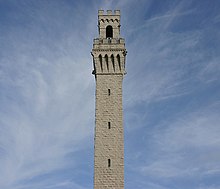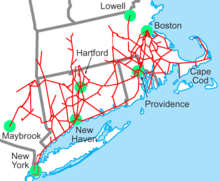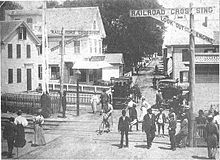Provincetown
| Provincetown | ||
|---|---|---|
 Provincetown |
||
| Location in Massachusetts | ||
|
|
||
| Basic data | ||
| Foundation : | 1727 | |
| State : | United States | |
| State : | Massachusetts | |
| County : | Barnstable County | |
| Coordinates : | 42 ° 3 ′ N , 70 ° 11 ′ W | |
| Time zone : | Eastern ( UTC − 5 / −4 ) | |
| Residents : | 3,415 (as of 2006) | |
| Population density : | 136.6 inhabitants per km 2 | |
| Area : | 45.2 km 2 (approx. 17 mi 2 ) of which 25.0 km 2 (approx. 10 mi 2 ) are land |
|
| Height : | 12 m | |
| Postal code : | 02657 | |
| Area code : | +1 508, 774 | |
| FIPS : | 25-55500 | |
| GNIS ID : | 0618258 | |
| Website : | www.provincetown-ma.gov | |
| Mayor : | Sharon Lynn | |
Provincetown is a city at the tip of Cape Cod in Barnstable County , Massachusetts in the United States . According to an estimate by the US Census Bureau, the population was 3415 in 2006. The city is sometimes called "P'town" and was a focus of the fishing and whaling industry until the end of the 19th century. Today Provincetown is known for its beaches, the natural harbor, the artists who live in the city and above all as a tourist destination , the latter in particular as a holiday destination for gays and lesbians .
history

The area was originally from Indians of the tribe Nauset settled that there is a settlement called Meeshawn had. When Provincetown was founded here in 1727, the place had served as a port for ships for more than a century. Bartholomew Gosnold gave his name to Cape Cod in 1602 in what was later to be the port of Provincetown . In 1620, the Pilgrim Fathers signed the Mayflower Treaty in the port , agreeing to settle and establish a self-governing community, and went ashore at the west end of the port. Although the Pilgrim Fathers chose to settle across the bay in Plymouth , Provincetown enjoyed an early reputation as a fishing district. The Province Lands were first officially recognized by the Association of the Plymouth Colony and Massachusetts Bay Colony in 1692 . The first regional administration was established there in 1714.
Provincetown's population remained largely stable for much of the 18th century. However, after the American Revolution , the city quickly grew into a center for fishing and whaling . An additional increase in population came about by Portuguese seafarers who had hired on American ships and now settled in Provincetown. In the 1890s, the city experienced a boom in growth. Writers and artists also began to settle there and a tourism industry for summer vacationers emerged. After the 1898 storm known as the Portland Gale caused severe damage to the city's fishing industry, many of the local artists took over the abandoned buildings. In the first decades of the 20th century, the city had already gained an international reputation for the art and literature that originated there. The Provincetown Players were a significant experimental theater group at the time and an example of the intellectual and artistic exchange with Greenwich Village that began then.
There are eight buildings and a historic neighborhood in the city that are on the National Register of Historic Places .
In the mid-1960s there was a further increase in population. The rural character of the city appealed to the hippies of the time and land prices were low, which - especially in winter - resulted in low rents. Many of them stayed in Provincetown permanently and raised families there. In the Commercial Street many new cafes, leather shops and emerged head shops .
Around the mid-1970s, increasing numbers of gays began to move to Provincetown. The Provincetown Business Guild (PBG) was founded as early as 1978 to specifically promote gay tourism. Today, more than 200 companies are members of the PBG and Provincetown is now one of the most famous gay vacation destinations on the American East Coast.
Land prices have risen sharply since the 1990s and the many home conversions have put some residents in financial difficulties. However, the crisis that set in on the American real estate market in 2005 has since led to real estate prices falling by 10 percent or more in less than a year. However, this has done no harm to the city's economy. The tourist season has now expanded to include festivals and week-long events throughout the year. The most famous are the Portuguese Festival and the Carnival Week of the PBG.
Culture
For those following the gay society's travel and events calendar, Provincetown is the preferred destination on the week of the July 4th holiday . The city is well enough visited at this time to allow two full series of events during Circuit Week , in which the organizers compete for the best boat tours, the most lavish dance events and the most famous DJs (and also the biggest income from tourism) .
Other notable festivals throughout the year include the Christmas - themed Holly Folly , Bear Week , Mate's Leather Weekend , Family Week , Single Men's Weekend , Provincetown Film Festival, and Provincetown Jazz Festival .
Provincetown is also home to three modern theater companies : The New Provincetown Players , Shakespeare on the Cape (SOTC) and the Gold Dust Orphans . While the New Provincetown Players tradition existing since 1915 Provincetown Players continue, is Shakespeare on the Cape , a relatively young group of graduates of the Guthrie Theater / University of Minnesota is BFA Actor Training Program. The Gold Dust Orphans have been playing in Provincetown and Boston since 1998.
Norman Mailer's novel Tough Men Don't Dance, and Annie Dillard's book The Maytrees is set mainly in Provincetown. Michael Cunningham has written a book about his years in Provincetown, Lands End, A Walk in Provincetown (2002, German 2003).
In 2003 Provincetown received a low-interest loan of 1.95 million dollars from the Rural Development program of the US Department of Agriculture to the MacMillan Pier in the port to modernize the city, primarily tourism and high-speed ferries serving. Between 2004 and 2007, the Provincetown Art Association and Museum received four different loans and grants from the Rural Development program totaling $ 3 million to expand the museum, provide air conditioning , and Hargood House as a historic building to restore and to cover deficits in museum operations. Since the mission of the Rural Development program is "to improve the economic opportunities and quality of life of all Americans in rural areas," the USDA still viewed Provincetown as a rural region in the 2000s that needed federal financial support from the US government Has.
geography
Provincetown is at the tip of Cape Cod . The city extends over an area of 45.2 km², of which 25 km² are land and 20.2 km² are water. The city of Truro borders to the east and Provincetown Harbor to the southeast. The Cape Cod Bay lies to the south and west, while the Massachusetts Bay is in the north. The city is 45 miles by land from Barnstable, Mass., 100 km from the Sagamore Bridge over the Cape Cod Canal, and 187 km from Boston (79 km as the crow flies).
Around two thirds of the land area is part of the Cape Cod National Seashore Reserve . North of the city are the Province Lands , an area of dunes and small ponds that stretches along the coast of Massachusetts Bay from Mount Ararat in the east to Race Point in the west. The coastline of Cape Cod Bay stretches from Race Point in the west to Wood End in the south and east to Long Point , which faces inward to the Cape and thus forms a natural barrier for the port of Provincetown. There are lighthouses on all three headlands , such as the Race Point lighthouse . The densely populated part of the city stretches along the harbor south of the Seashore area.
traffic

Provincetown is the eastern end of US Highway 6 , both state and national. Although this is officially referred to as the east end of the highway, at its endpoint, which is only marked by the intersection with Route 6A, the road has circled Cape Cod once and runs there in a west-southwest direction. The state-controlled section of the road ends at the point where it changes to the Cape Cod National Seashore area , from where it is under federal administration. For a long time it followed the course of Commercial Street within the city until it was converted into a one-way street and a bypass was created. Route 6A also crosses the city and largely follows the course of Bradford Street and ends just south of Herring Cove Beach .
Seasonally, Provincetown is also connected to Boston and Plymouth by ferries from MacMillan Pier east of City Hall.
The city has had no rail service since the route was abandoned by the New York, New Haven and Hartford Railroad in the early 1960s .
The Provincetown Municipal Airport is located east of Race Point , has an ILS -taugliche, 1067 m long runway and is mainly used for private aviation as well as several short-haul flights scheduled flights to Logan International Airport in Boston.
Demographic structure
Information from the United States census
According to the United States Census of 2000 , at that time there were 3,431 people in the city, spread over 1,837 households and 464 families. The population density was 137.1 inhabitants / km². There were 3890 residential units, which corresponds to a density of 155.5 apartments / km². The ethnic groups are distributed as follows: 88.55% Caucasian Ethnicity , 7.52% African American , 0.5% Asian American , 0.32% Native American , 1.08% from other lineages and 3.03% with descent from various ethnic groups. The Hispanics and Latinos represent 2.16% of the population. The most numerous ethnicities mentioned were Portuguese (22.6%), Irish (13.9%), English (10.4%) and Italian (8.7%)
9% of the households had children under the age of 18 and 17.7% consisted of married couples living together. 5.3% of households belong to single women, 74.7% belong to non-family communities. 53.2% were single households and 14.5% were single-person households of people over 65 years of age. The average household consisted of 1.69 people, the average family of 2.65.
The population was divided into 8% under 18 years of age, 5.2% between the ages of 18 and 24, 36.1% between 25 and 44, 32.9% between 45 and 64, and 17.8% over 65 years of age old. The average age at marriage was 45 years. For the total population, there are 115.5 men for every 100 women, and 116.2 men for those over 18.
The median annual income for a household is $ 32,716, and the median family income is $ 39,679. The median income for males was $ 30,556 and females of $ 25,298. The per capita income was $ 26,109. About 8.5% of families and 16.3% of the population live below the poverty line , 22.7% of those under 18 and 17% of those over 65.
The Provincetown zip code area has the highest density of same-sex households of any postal delivery district in the United States.
Demographic composition in a vacation spot
Traditional sources such as the United States Census, voter lists and land registry entries are unable to fully reflect the demographic composition of a city that is heavily influenced by tourism . Although the number of permanent residents is relatively small and declining, the population is estimated to be 60,000 in the summer months.
Economic statistics based on census numbers can also be misleading. This includes 3890 apartments, but only 1837 households. There is also an obvious discrepancy between the median annual income of a household ($ 32,716) and the median value of a home ($ 323,600).
Residents who have a second place of residence in Provincetown, where they live less than 6 months a year, are not included in the census, even though they pay taxes there, have a job or even have business operations there.
politics
Provincetown is represented in the Massachusetts House of Representatives as part of the fourth district of Barnstable County , which - with the exception of Brewster - includes all cities east and north of Harwich. In the Massachusetts Senate, the city is represented as part of the Cape and Islands District, which includes all of Cape Cod, and the islands of Martha's Vineyard and Nantucket . (Again with the exception of the towns of Bourne, Falmouth, Sandwich, and part of Barnstable.)
At the federal level, the city belongs to the 10th congressional electoral district of Massachusetts and is currently represented by Bill Delahunt. The senior representative (Class I) in the United States Senate is Edward "Ted" Kennedy , who was re-elected in 2006 , and the Junior Senator is John Kerry (Class II) , who is up for re-election in 2008 .
Provincetown itself is governed by an open people's assembly, the administration is led by a town manager together with a board of selectmen . The city has its own police and fire department.
education
Provincetown operates its own schools for around 200 school-age children in the city. The Veterans Memorial Elementary School serves students from kindergarten to sixth grade, the Provincetown High School (also receives the student from Truro) is students from grades 7 to 12 open. There are no private schools in Provincetown, but students can attend Cape Cod Regional Technical High School in Harwich or Nauset Regional High School in North Eastham for free.
Known residents
- The writers Tennessee Williams (1911–1983), Eugene O'Neill (1888–1953) and Susan Glaspell (1876–1948).
- The poet Laureate Stanley Kunitz (1905-2006).
- The international journalists Mary Heaton Vorse , John Reed (1887–1920) and Louise Bryant (1885–1936).
- The visual artists Charles Webster Hawthorne , E. Ambrose Webster , Marsden Hartley (1877–1943), Robert Motherwell (1915–1991), Hans Hofmann (1880–1966), Franz Kline (1910–1962), Willem de Kooning (1904– 1997), Jackson Pollock (1912–1956), Peter Hutchinson (* 1930), Herman Maril, Nancy Whorf and Henry Hensche (1899–1992).
- Arctic explorer Donald B. MacMillan
- The author Norman Mailer (1923-2007), Pulitzer Prize winner and co-founder of Village Voice .
- The Pulitzer Prize-winning poet Mary Oliver (1935–2019).
- The film director John Waters (* 1946).
- Michael Cunningham (* 1952), author of the Pulitzer Prize-winning novel The Hours .
- Andrew Sullivan (* 1963), author and columnist for Time Magazine and blogger .
- The poet Andy Towle , founder of Towleroad.com.
- Al Jaffee (* 1921), draftsman for MAD magazine .
- The poet and author Mark Doty .
- The LGBT pioneer Prescott Townsend .
- The screenwriter Mark Protosevich (* 1961), whose works include the scripts for The Cell , The Poseidon Attack and, most recently, I Am Legend .
- The author and LGBT activist Urvashi Vaid (* 1958).
- The photographers: Joel Meyerowitz (* 1938), Norma Holt and Charles Fields.
- The painter, illustrator and author Frederick Judd Waugh (1861–1940).
gallery
Memorial plaque for the signing of the Mayflower Treaty
Memorial stone for the dead of the crossing of the Mayflower
literature
- Karen Christel Krahulik: Provincetown: From Pilgrim Landing to Gay Resort. NYU Press, New York 2007, ISBN 978-0-8147-4761-2 .
Individual evidence
- ^ Estimate by the US Census Bureau based on the 2000 and 1990 censuses.
- ↑ Gabriel Archer: Great Epochs In American History: The Relation of Captain Gosnold's Voyage . Ed .: Ed. Frances Healey. Funk & Wagnalls Co., 1912, p. 38 ( usgennet.org ).
- ↑ Shebnah Rich: Truro Cape Cod or landmarks and Sea Marks . D. Lothrop & Co., Boston 1883, p. 53 ( google.com ).
- ^ Simeon L. Deyo: History of Barnstable County . HW Blake & Co., New York 1890, p. 961 ( capecodhistory.us ).
- ↑ David Colman: Rich Gay, Poor Gay . New York Times , September 4, 2005 ( nytimes.com ).
- ↑ Gaul, Gilbert M. and Cohen, Sarah: Rural Aid Goes to Urban Areas: USDA Development Program Helps Suburbs, Resort Cities . Washington Post, April 5, 2007 ( washingtonpost.com ).
- ↑ The Mission Statement of the USDA Rural Development Program ( Memento from June 10, 2010 in the Internet Archive )
- ^ Boston-Provincetown ferry
- ↑ Plymouth-Provincetown ferry ( Memento of the original from April 12, 2007 in the Internet Archive ) Info: The archive link was automatically inserted and not yet checked. Please check the original and archive link according to the instructions and then remove this notice.
- ↑ Information from the US Census 2000 for Provincetown
- ^ Facts and Findings from The Gay and Lesbian Atlas , Urban Institute, March 30, 2004
- ↑ Insiders.com: Getting Here, Getting Around Tips ( Memento of September 27, 2007 in the Internet Archive )
- ^ Directory of legislative representations at Mass.gov











